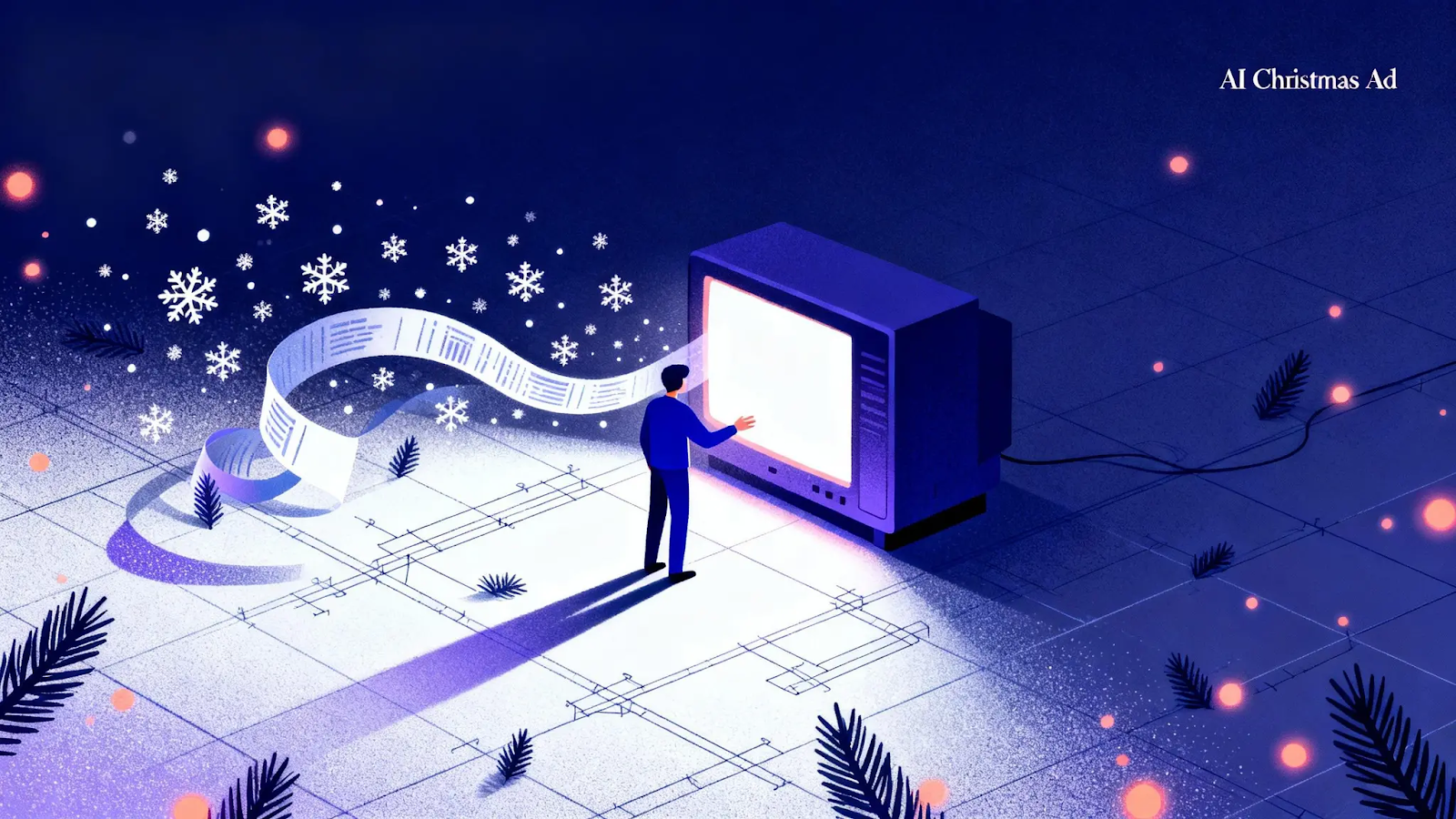Did Coca-Cola's AI Generated Christmas Ad Just Start a War Online?
What happened with Coca-Cola's AI generated Christmas ad and why is everyone talking about it? Click now to see the full story!

Coca-Cola released an AI generated Christmas ad built around warm lights, winter streets, and classic holiday sentiment last year. The visuals looked familiar at first, until viewers learned that the imagery was made using AI. Reactions split almost immediately. Some praised the craft and speed. Others rejected it the moment they discovered how it was made.
Is AI allowed to carry emotional storytelling for a brand built on nostalgia? Does intent matter if the final result still triggers the same feelings? Many viewers said no. They felt the meaning collapsed once people learned it was not made by humans.
This blog explains what happened with the Coca-Cola's AI generated christmas ad. Let’s look into how people reacted, the ethical questions raised, and what this moment could signal for future advertising.
If You Read Only One Section, Read This
- Coca-Cola kept the same Christmas mood but swapped humans with AI behind the curtain.
- The ad felt warm until viewers learned it was machine-made. That moment flipped the mood.
- The fight is not about how it looks. It is about whether machine-built emotion should count as real.
- Supporters call it progress and cost control. Critics call it the first visible cut into creative labor.
- Other brands are now watching this backlash to decide how far they can push AI before trust breaks.
What Happened With the Coca-Cola's AI Generated Christmas Ad and Why It Went Viral
Coca-Cola released a Christmas ad built entirely with AI instead of filming with actors, sets, or physical locations. The visuals delivered the usual nostalgic holiday mood; but the production method was completely different. Let’s dissect how:
What the ad included
- Fully digital festive environments
- A 3D-recreated Santa as the central character
- Cozy holiday interiors and city streets rendered in AI
- Storytelling aligned with Coca-Cola’s familiar Christmas tone
How the ad was made
- Every frame was AI generated instead of shot or animated traditionally
- No physical sets or actors were used
- A global team guided AI prompts to keep the brand’s narrative consistent
- Rapid iteration let the team test many variations in weeks instead of months
Why it went viral
- A legacy brand using AI for a sentimental holiday campaign
- Surprise factor once audiences learned it was AI made
- Curiosity around whether AI can replace emotional commercial work
- The topic triggered immediate debate across social platforms
Start Crafting Stunning Feature Images with PixelFlow on Segmind!
How the Coca-Cola's AI Generated Christmas Ad Was Made?
Coca-Cola’s AI-generated Christmas ad demonstrates how AI can transform advertising by combining speed, scale, and creativity. By blending advanced AI tools with human oversight, the team delivered polished visuals while dramatically reducing production time. Here’s a step-by-step look at how the ad came to life:
- Multi-tool AI pipeline: Leonardo, Luma, Runway, Kling and segmentation tools generated characters, scenes, and clean separations without physical sets or actors.
- Prompt-driven direction: A large creative team wrote structured prompts for actions, shots, mood, and lighting to keep the story on-brand.
- Mass frame generation: Thousands of frames and variations were produced and composited rapidly, enabling fast iteration without reshoots.
- Human correction layer: Editors fixed glitches, smoothed sequences, and preserved emotional flow so it still “felt” like a Coca-Cola Christmas ad.
- Time and cost compression: Delivered in ~2 months instead of a year, with AI handling volume and humans keeping narrative and brand intact
Bring your ideas to life in stunning 4K with Seedream 4.0
Support vs Backlash on the Coca-Cola's AI Generated Christmas Ad
You do not get a mild middle zone on this topic. People are either comfortable with AI being used in a sentimental campaign or they reject it the moment they realize it was not human-made. The arguments fall cleanly into two opposing buckets.
Arguments Side by Side
Also Read: Generative AI news, insights, and ideas by Segmind
Ethical Questions Sparked by the Coca-Cola's AI Generated Christmas Ad
You are not only looking at a production switch. You are looking at an emotional format that is normally trusted because people make it. The ethical tension begins when the audience reacts as if it was human-crafted while it was not.
AI in Emotional Persuasion: Acceptable or Manipulative?
You are asked to feel something built by a model without being told. The response looks the same whether a director made it or a diffusion system did. For many viewers, that gap between belief and origin feels like emotional persuasion without disclosure.
Drivers of discomfort
- Trust is granted to a source that is hidden
- Viewers react as if humans crafted it when none did
- AI emotion prompts action on a false assumption
Is This the Start of Creative Labor Replacement?
You are looking at a case where actors, set teams, and post-production were all removed and replaced with prompt-driven output. That change shifts money and opportunity out of creative labor and into tools that do not need crews.
Tension points
- Payroll and full departments are collapsed into software cycles
- Brands gain control and revision speed without physical friction
- Junior workers lose the training ground where skills are built
Also Read: Change Background of Images like a Pro using ControlNet Inpainting
What the Coca-Cola's AI Generated Christmas Ad Signals for the Future of Ads
You are not just watching one brand experiment. You are seeing a test case that other brands will measure before deciding whether to copy or avoid it. The reaction becomes input for future budgets and approvals.
Pressure factors that shape what comes next
- If audience tolerance remains high, you will see more AI-first holiday and brand films
- If backlash escalates into trust loss, brands may restrict AI to internal or non-emotional work
- Speed and cost efficiency compete directly with perceived authenticity and craft identity
- Evaluation shifts from who made it to whether it performs on screen and on metrics
- AI workflows give executives more control and fewer dependencies on human talent cycles
No predictions are needed. The tension itself is enough to change how the next round of approvals and briefs are written.
Final Thoughts
You are left with the same core question as the title: was this a smart stress test or a misjudged risk. The ad itself is not the event. The reaction is the event. The clip is only a trigger. The debate about machine-made sentiment, authorship, and acceptable substitution is the actual outcome.
With Segmind, you can experiment with AI-generated visuals, refine ideas, and bring concepts to life quickly, all on one platform without complex setups or technical hassle.
Start creating AI images with Segmind today and explore the possibilities of AI-driven marketing.
Start Using Next-Gen AI Tools on Segmind Today
Frequently Asked Questions
1. What AI tools were used for Coca-Cola’s Christmas ad?
Coca-Cola used AI tools like Leonardo, Luma, Runway, and Kling, along with 3D rendering and image processing tools to create the visuals, characters, and holiday scenes.
2. Was the ad fully AI-generated?
Yes. All visuals, including the characters and backgrounds, were made by AI. But human editors checked the work to make sure it looked good and told the story clearly.
3. Why did some people call the ad “soulless”?
Even though it looked impressive, the ad didn’t feel warm or nostalgic like traditional holiday ads. AI can’t fully copy the small human touches that make viewers feel connected.
4. How long did it take to make the ad?
The AI workflow allowed the ad to be finished in about 2 months, instead of the usual 12 months for traditional filming.
5. Is AI replacing human creativity in ads?
Not yet. AI can speed up work and create visuals, but humans are still needed for storytelling, emotions, and making the ad feel real.
6. What can marketers learn from this campaign?
Use AI for tasks that are repetitive or take a long time, be transparent about AI use, and combine it with human creativity to keep the ad emotional and relatable.
7. Can other brands do the same thing?
Yes, but they need good planning, ethical checks, and human creative input. Without this, AI ads may feel unnatural or fail to connect with viewers.

